#about peter and harry's first meeting after harry comes back to new york from europe. before they become roomies.
Explore tagged Tumblr posts
Text
Illicit affairs | Masterlist
summary: y/n stark returns after she escaped New York & peter’s rather anxious to see her after what happened between them. But neither fury or tony care about it and assign a mission to them: capture black cat and kingpin. Should be easy right? No, lol. While y/n and peter try to navigate their new “friendship” and try work together to capture kingpin, y/n gets tangled with one pretty felicia hardy and peter doesn’t like it at all. Jealousy doesn’t suit peter or y/n, secret meetings are a must, partying too and even a couple of hookups; everything to save the world, right?

Prologue: y/n comes back from spending one year and a half in Europe for a mission, peter’s nervous as hell for her return and tony is not having any of their shit, so instead of buying an oversize “get-along-shirt” he decides to place them in a “get-along-mission”.
Dreams- Fleetwood Mac & Illicit affairs -Taylor swift.
Chapter 1: harry osborn is a flirt and justin hammer is a jackass. y/n tells peter that he is an idiot, again. & black cat wants to know what night are they talking about.
Maniac - Conan Grey & my tears ricochet - Taylor Swift.
Chapter 2: y/n and peter make the adults laugh -not intentionally-, y/n has always been the designated driver, she never deletes footage and can someone tell gwen that nobody likes her when she’s being possessive?
Venus- Shocking Blue & Daddy Issues -The Neighbourhood
Chapter 3: who doesn’t love to sneak out to a club full of criminals? ok, that was not fair for peter, but at least he can still kick ass. Plus, someone’s not happy to see that y/n is back.
Kiwi- Harry Styles & Dakiti- Bad Bunny
Chapter 4: tony can’t catch a break with his daughter, y/n receives an unexpected call and then goes for a little day trip to coney island and for peter somethings sus.
Girls like Girls- Hayley Kiyoko & Ta reine- Angèle
Chapter 5: y/n gets way too flustered when she returns from “researching”, clandestine meetings and locked bathrooms in parties are a must. Plus, peter wants to know what the hell is wrong with you?
Break up with your girlfriend, I’m bored- Ariana Grande & Carolina- Harry styles
Chapter 6: kingpin is on the move; peter is a sad mess that doesn’t understand why y/n keeps secrets while she needs to answer a call and tony has a crush on dr. strange.
august- Taylor Swift & Hopelessly devoted to you- Olivia Newton- John
Chapter 7: y/n is done with bullets and would like to live in timeloops; plus, she has an honest talk with peter for the first time in forever. Both felicia and peter can climb walls, interesting.
Lights up - Harry Styles & Woman- Harry Styles
Chapter 8: imagine the met gala but ten times better and in stark tower, that’s it. felicia doesn’t have very good manners and sneaks away with y/n but peter and his friends are on the lookout.
Do I wanna know -Arctic Monkeys & bad idea- girl in red
Chapter 9: the power of a girl after a break up? Let me tell you. felicia learns a thing or two about trusting the wrong people and peter just really really wants you to be happy.
Champagne problems- Taylor Swift & These boots are made for walkin’ – Nancy Sinatra & Rolling in the deep- Adele
Epilogue: y/n and Peter feel in heaven when they are together but something’s bothering y/n so she decides to take a small trip for old time’s sake.
willow- Taylor Swift. Coney Island - Taylor Swift
#peter parker#peter parker series#peter parker masterlist#peter parker au#peter parker avengers#peter parker angst#peter parker blurb#peter parker college au#peter parker fanfic#peter parker fanfiction#peter parker headcanon#peter parker imagine#peter parker mcu#peter parker oneshot#peter parker x reader#peter parker x y/n#peter parker x stark!reader#spiderman headcanon#spiderman#spiderman series#spiderman imagine#tom holland#tom holland imagine#tom holland fanfiction#tom holland one shot#tom holland x y/n#tom holland x you#tom holland smut#peter parker smut#peter parker fluff
594 notes
·
View notes
Note
im pretty new to spider-man comics so i was wondering if their are any comics focused/centered on harry osborn or gwen stacy? or both of them? and if there is what are some of your favorites?
Hi anon! Welcome to Spider-Man comics. I have a Gwen Stacy reading list here. It’s relatively straightforward reading Spider-Man comics for Gwen -- unfortunately she’s alive for such a brief period of the canon that you can cover it fairly easily. I thought I had a reading list for Harry, but I can’t find it, and the one I’ve used before that was made by someone else appears to be gone now. So a quick Harry Osborn reading list!
Harry, like Gwen, first appears in Amazing Spider-Man #31 -- they knew each other before the start of the series and were friends in high school. While there’s a pretty immediate push and pull between Peter and Gwen, Peter and Harry’s relationship isn’t immediately magnetic. He and Peter first begin to become friends in Amazing Spider-Man #39. In Amazing Spider-Man #40, Norman rants about his relationship with Harry to a captured Peter, with Norman’s words clearly contrasted against flashbacks: Norman claims he was a great father to Harry where the flashbacks show he was, at best, emotionally neglectful. In ASM #46, Harry asks Peter to move in with him while they attend college and Peter accepts. In ASM #74, Harry debuts a horrible mustache. I wouldn’t necessarily count this as important-important, but it’s just something everyone needs to see.
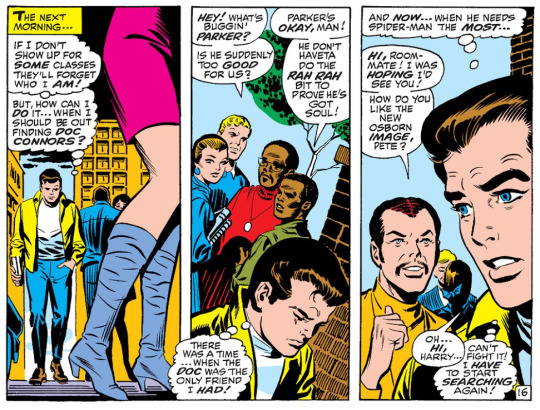
The mustache is very short lived. In ASM #96-98, cracks in Harry and Mary Jane’s relationship begin to show and Harry’s drug use increases, leading Peter to beat up his dealers, while Norman Osborn’s buried memories of the Green Goblin begin to reassert themselves. In ASM #119-122, Harry relapses, unwittingly setting in motion the events that would lead to Gwen’s death at the hands of Norman Osborn. Harry is in the throws of an overdose when Peter confronts him while searching for Norman immediately after Gwen’s death. The stress caused by Norman and Gwen’s deaths is evident in Harry in ASM #125. In ASM #135-137, Harry discovers Peter’s Spider-Man costume and plots his revenge, believing that Spider-Man killed his father. This is the first appearance of Harry’s own Green Goblin persona, and he’s institutionalized following a confrontation with Spider-Man.
Harry next appears in ASM #151, appearing to have lost or repressed all his memories related to Peter being Spider-Man. He first meets Liz Allan, his future wife and Peter’s former classmate, in ASM #156, at Betty Brant and Ned Leeds’ wedding. He and Liz start seeing each other in ASM #157 and announce their engagement in ASM #166. In ASM #172-180, Liz is arrested following the reappearance of her stepbrother, Mark “the Molten Man” Raxton. She subsequently breaks up with Harry and Harry goes a little off the rails before he and Liz reunite. Not too long after this point, Harry and Liz get married off page and move to New Jersey. In Spectacular Spider-Man #63, Mark Raxton returns and threatens the Allan-Osborn home. In Spectacular Spider-Man #85, Harry and Liz announce they’re expecting a child.
In ASM #249-251, while Peter is attending a party at Liz and Harry’s place, Harry receives a disturbing letter attempting to blackmail him for his father’s crimes. This story is a big step towards Harry accepting what his father did as the Green Goblin. In ASM #260-261, Liz and Mary Jane are taken hostage and Harry unsuccessfully attempts to rescue them, leading to one of my favorite Harry moments which I think showcases that, deep down inside, Harry is an extraordinarily gentle person -- and that this tendency towards gentleness hurts him as much as it is an admirable quality. I think it’s an important trait when comparing him to Peter, that Harry is essentially a weak person, and that that weakness isn’t inherently negative -- it might even, in different circumstances, make Harry a more admirable, definitely a more inherently gentle person than Peter, but that it doesn’t serve Harry in their circumstances and leads him to unfairly and unfavorably compare himself to Peter, much to his own detriment.
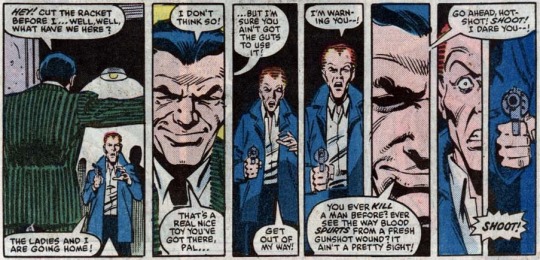
In ASM #263, Harry and Liz’s son Norman “Normie” Osborn Jr. is born. Things are quiet for Harry for a bit, until Marvel’s Inferno event begins. (It’s a good event, don’t worry. It’s primarily an X-Men event and I recommend the whole thing. Daredevil fights a vacuum cleaner in it.) The relevant Spider-Man issues for the whole event are ASM #311-313, Spectacular Spidey #146-148, and Web of Spider-Man #47-48. If your primary focus is Harry, you can stick to the relevant Spectacular and Web of issues -- this is an important moment in Harry’s history, where Norman’s influence and memories of the Green Goblin begin to reassert themselves on Harry, and at one point an Oscorp building is the scene of the Inferno action. In ASM #321, while helping Liz and Harry move into a new New York home, Harry invites Peter and Mary Jane, currently without a permanent address, to move into the top floor of the building. Liz’s brother the Molten Man makes a reappearance in Web of Spider-Man #62, where Harry offers him a job with Oscorp. In Web of Spider-Man #66-67, Harry dons the Green Goblin costume again, this time to try and be a hero before Spider-Man intervenes.
Things at this point go downhill for Harry very quickly: he begins, depending on your interpretation, either hallucinating his father or having visions of his ghost in Spectacular Spider-Man #178-183, in a storyline called The Child Within.
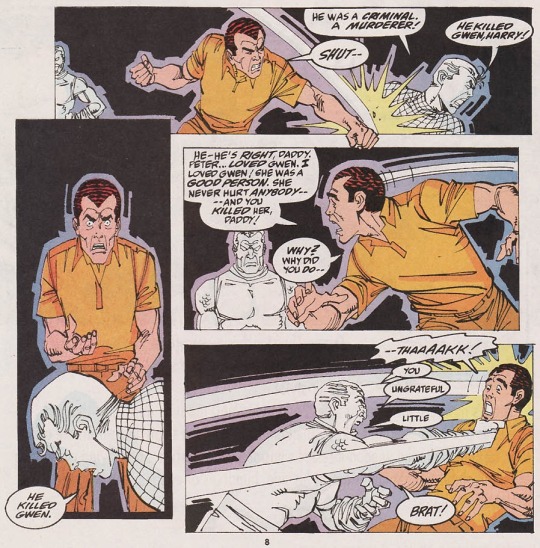
This is in my opinion one of the strongest Spider-Man stories ever written and a very critical storyline for Harry in particular, but as a warning it deals fairly explicitly with childhood sexual abuse of a minor character who is, I would say, deliberately paralleled against Harry and Harry’s experiences in childhood. It’s amazingly done -- J.M. DeMatteis wrote it and he’s one of my favorite Spider-Man writers -- but it is very, very intense. This leads to a confrontation between Peter and Harry, during which the apparition of Norman urges Harry to kill Peter, but Harry cannot. In all honesty, I would recommend reading from The Child Within straight through to Spectacular Spider-Man #200, which is Harry’s death. Harry’s not present in every issue, but he lingers over every page like a threat, and it’s some seriously well done comic book storytelling. But if you just want the issues where Harry is present: Spectacular Spider-Man #184, #188, #189, #190, #199. But whatever you do, don’t miss Spectacular Spider-Man #200. It’s hands down my favorite single issue of Spider-Man.

So at this point Harry’s dead. You’d think there wouldn’t be very much to read between this point and his resurrection in Amazing Spider-Man’s Brand New Day but there’s still a few points to hit: Harry’s video will is read in Spectacular Spider-Man #204, and there’s some elaborate Osborn family flashbacks in Spectacular Spider-Man Annual #14. Harry also arranged, although it was carried out posthumously, for the whole Robot Richard and Mary Parker debacle, which you can read using this guide from the Complete Marvel Chronology Order + Amazing Spider-Man #390.
Harry returns to the pages of Spider-Man in Amazing Spider-Man #545, following the erasure of Peter and Mary Jane’s marriage that came with Peter’s deal with Mephisto in the wake of Civil War. Recently returned from Europe, Peter and Harry spend a lot of time together as Harry does his socialite thing and engages in a relationship with Lily Hollister, the daughter of a New York mayoral candidate. Relevant issues are ASM #546-549, #552, #554, #557-561, #565, #567-569, #571-573, #581-588. Amazing Spider-Man #595-599 is one of my favorite Harry Osborn stories, American Son. A rare can’t miss where Brand New Day is concerned. With Dark Reign in full swing, Norman Osborn is on top of the world and in charge of a new Avengers team -- and he wants Harry to come work for him. (Not to be confused with the three issue limited series called Amazing Spider-Man Presents: American Son, which Harry is in, but which I don’t necessarily recommend.)

Amazing Spider-Man Extra! #3′s “Nice Things” focuses on Harry’s childhood and on Harry in the wake of American Son. Harry also appears in ASM #602-605 (enjoy the plotline where he dates Peter’s hot cousin), #609-610, #621-622, #630, #642-647 -- which details the birth of Harry’s second child, Stanley Osborn. Harry disappears from the pages of Spider-Man for a bit at this point as everything goes completely to hell with the Superior Spider-Man plot, where Doc Ock steals Peter’s body. Harry makes a reappearance when Peter, who has taken back his body, is left to deal with the aftermath of Doc Ock’s actions, finding himself the CEO of a huge tech company. Harry goes to work for him. I don’t think any of this is particularly worth reading for Harry, certainly not in comparison to any of the previous comics mentioned, but Harry is present for Amazing Spider-Man (2015) #3, #7, #10-15, #25-28, ASM #789-791, and #797-800. Some of this is event territory, and a lot of it is just not very good. The one part of it I would recommend is ASM #789′s Harry scenes, which are about him and Liz getting back together. And that’s where we stand currently for Harry! Thanks a lot to Spencer’s run for neglecting him for like fifty whole issues now.
My other Harry and Gwen rec would be for the current Gwen Stacy series, written by Christos Gage and illustrated by Todd Nauck. This is my current favorite Spider-Man book on the shelves, even though we’ve only gotten two issues of it so far. It’s set during Gwen and Harry’s high school days, before they meet Peter, and fits perfectly into the Spider-Man canon of the time. The two issues released have had a big focus on Gwen and Harry’s relationship, with Gwen running for class president and Harry as her campaign manager/hype man.

Please return to the shelves, Gwen Stacy solo.
#gwen stacy#harry osborn#marvel comics#spiderman#comic recs#traincat talks comics#long post/#*replies
102 notes
·
View notes
Photo

‘The Crown’ Stokes an Uproar Over Fact vs. Entertainment
Dramatic liberties in the latest season of the Netflix series, covering the turbulent 1980s, are annoying Britons who wrote of that period, even among those who disparage the royals.
By Mark Landler Nov. 27, 2020 LONDON — On a Saturday night in July 1986, a band of bureaucrats in raincoats — one contingent from Buckingham Palace, the other from 10 Downing Street — converged on a newsstand in a train station to snap up The Sunday Times, fresh off the presses with a bombshell headline: “Queen dismayed by ‘uncaring’ Thatcher.”
It’s a dramatic flourish from the latest season of the “The Crown” — except, according to Andrew Neil, the paper’s editor at the time, it never happened. “Nonsense,” he said. “All first editions are delivered to both” the palace and the prime minister’s residence, making a late-night dash to buy the paper superfluous.
Mr. Neil, who published the famous scoop about tensions between Queen Elizabeth II and Margaret Thatcher, said the invented scene had allowed Peter Morgan, the creator of the hugely popular Netflix series about the British royal family, to depict 1980s London as a place of “squalor and vagabonds.”
Through four vivid seasons of “The Crown,” Mr. Morgan has never denied taking artistic license with the saga of the royals, playing out their private joys and sorrows against the pageant of 20th-century British history.
Yet “The Crown” is now colliding with the people who wrote the first draft of that history.
That has spun up a tempest in the British news media, even among those who ordinarily profess not to care much about the monarchy. Newspapers and television programs have been full of starchy commentary about how “The Crown” distorts history in its account of the turbulent decade in which Prince Charles married Lady Diana Spencer and Mrs. Thatcher wrought a free-market revolution in British society.
The objections range from the personal (the queen’s brittle, coldhearted treatment of her emotionally fragile daughter-in-law, which the critics claim is unfair) to the political (the show’s portrait of Thatcher-era Britain as a right-wing dystopia, in the grip of a zealous leader who dares to lecture her sovereign during their weekly audiences). Historians say that is utterly inconceivable.
“There has been such a reaction because Peter Morgan is now writing about events many of us lived through and some of us were at the center of,” said Mr. Neil, who edited The Sunday Times from 1983 to 1994.
Mr. Neil, who went on to be a broadcaster and publisher, is no reflexive defender of the royal family. Suspicious of Britain’s class system, he said he had sympathies for the republican movement in the 1980s. But he grew to admire how the queen modernized the monarchy after the upheaval of those years, and has been critical of renegade royals, like Prince Harry and his wife, Meghan.
The events involving Mr. Neil did happen: The queen became frustrated with Mrs. Thatcher when she refused to join the 48 other members of the British Commonwealth in backing sanctions against the apartheid regime in South Africa. This highly unusual clash spilled into public when The Sunday Times published its front-page report, attributed to palace officials, which said the royal family viewed Mrs. Thatcher as “uncaring, confrontational and socially divisive.”
But Mr. Neil disputed several elements of “The Crown’s” retelling, not least that Buckingham Palace made the queen’s press secretary, Michael Shea, the scapegoat for the incident. The show depicts his being fired for having leaked the story, even though it suggests that he did so at the queen’s behest. There is no evidence of this, Mr. Neil said, but it fits Mr. Morgan’s “left-wing agenda.”
“He gets to depict Thatcher as pretty much an ally of apartheid while the queen is the sort of person who junks loyal flunkies when things go wrong, even when they are just doing her bidding,” Mr. Neil said.
The brickbats are not just from the right.
Simon Jenkins, a columnist for the left-leaning Guardian, regards members of the royal family as artifacts of celebrity culture irrelevant to a country grappling with real-world challenges like Brexit. “They are practically defunct,” he said. “They are like anthropomorphized figures of a head of state.”
Yet he, too, is angered by how “The Crown” portrayed the events of the 1980s, when, as political editor of The Economist, he wrote about how Prince Charles had been drawn to the now-defunct Social Democratic Party. (He based the report on an off-the-record interview with the prince.) Mr. Jenkins said that because this season of “The Crown” deals with contemporary history and people who are still alive, its liberties with the facts are less a case of artistic license than an example of “fake news.”
“I find it offensive when people dump standards of veracity in relating contemporary history,” Mr. Jenkins said. “If I did that as a journalist, I’d be hauled up before the press council while these people get prizes.”
Like others, Mr. Jenkins pointed to an episode-by-episode analysis by Hugo Vickers, a royal historian, which found whoppers large and small in the series and has become Exhibit A for its prevarications.
Not everybody faults Mr. Morgan for filling in the missing pieces with conjured scenes, even if he jumbles the facts in the process. (Mrs. Thatcher’s son, Mark, was not lost in the desert during the Paris-Dakar auto rally just as his mother was preparing to go to war with Argentina over the Falkland Islands; hostilities broke out a few months after he was found.)
Charles Moore, a former editor of The Daily Telegraph who wrote a three-volume biography of Mrs. Thatcher, praised Gillian Anderson’s performance as the prime minister, putting it on a par with Meryl Streep’s Oscar-winning turn in the 2011 film “The Iron Lady.” Even a much-criticized episode in which a snobbish queen plays host to a fish-out-of-water prime minister and her husband, Denis, at Balmoral Castle in Scotland, struck him as having “the ring of truth,” despite some embellishments.
Charles Moore, a former editor of The Daily Telegraph who wrote a three-volume biography of Mrs. Thatcher, praised Gillian Anderson’s performance as the prime minister, putting it on a par with Meryl Streep’s Oscar-winning turn in the 2011 film “The Iron Lady.” Even a much-criticized episode in which a snobbish queen plays host to a fish-out-of-water prime minister and her husband, Denis, at Balmoral Castle in Scotland, struck him as having “the ring of truth,” despite some embellishments.
“The Crown,” Mr. Moore said, is trying to have it both ways, selling itself to audiences as a true story while clearing out the extraneous debris of facts that would gum up its dramatic narrative. “There is this thing called the tyranny of fact,” he said. “But as we get to modern times, it gets harder to avoid.”
Mr. Morgan declined to respond to the criticisms, though he told The New York Times this month that he was mindful that this season would be held to closer scrutiny. The producers mined the copious news reports of the period, as well as biographies of Charles and Diana, which contained firsthand accounts of their misbegotten union.
What is depicted in the family’s private moments, however, is “an act of creative imagination,” Mr. Morgan has said.
Behind the frustration with “The Crown” is a recognition that, right or wrong, its version of the royal family is likely to serve as the go-to narrative for a generation of viewers, particularly young ones, who do not remember the 1980s, let alone the more distant events covered in earlier seasons.
“They’ll watch it and think this is the way it was,” said Dickie Arbiter, who served as a press secretary to the queen from 1988 to 2000. He took issue with parts of the plot, including a scene in which aides to Charles question Diana about whether she is mentally stable enough to travel alone to New York City.
“I was actually at that meeting,” Mr. Arbiter said. “No courtier would ever say that in a million years.”
The biggest problem, said Penny Junor, who has written biographies of Charles, Diana and Mrs. Thatcher, is that “The Crown” is a prodigiously effective piece of entertainment. That, she says, poses a particular threat to Charles, who arguably comes off worst in the series and who is likely to ascend the throne before memories of his grim, hunched portrayal have completely faded.
“It is wonderful television,” Ms. Junor said. “It is beautifully acted — the mannerisms are perfect. But it is fiction, and it is very destructive.”
Royal Skulduggery and Palace Intrigue
‘The Crown’ Has Had Its Scandals, but There’s Nothing Like DianaNov. 12, 2020
Companies Abandon Prince Andrew After Calamitous Epstein InterviewNov. 19, 2019
Prince Andrew’s Friendship With Epstein Joins a List of Royal ScandalsNov. 21, 2019
Harry and Meghan’s Hard ExitJan. 19, 2020
Meghan, Duchess of Sussex, Shares Her Miscarriage GriefNov. 25, 2020
Mark Landler is the London bureau chief. In 27 years at The Times, he has been bureau chief in Hong Kong and Frankfurt, White House correspondent, diplomatic correspondent, European economic correspondent, and a business reporter in New York. @MarkLandler
A version of this article appears in print on Nov. 27, 2020, Section A, Page 12 of the New York edition with the headline: ‘Nonsense’: Witnesses to the Actual Events of ‘The Crown’ Have Some Criticisms.
Order Reprints Today’s Paper Subscribe
https://www.nytimes.com/2020/11/26/world/europe/Crown-Royals-Fact-Fiction.html
3 notes
·
View notes
Text
The Spidey Squad
(My interpretation on how Spidey Squad would work)
Ned Leeds. The guy in the chair: Ned and Peter go way back. After the battle of New York Ned’s family had to move and conveniently they moved into the same apartment building the parkers resided in. There weren’t many children there at the time so May and Ned’s parents were thrilled to get the boys interacting. The boys bonded over Star Wars and Lego and the rest is history. Peter totally willingly told Ned that he was spiderman during their freshman year of high school. Since then Ned promised to help Peter on his spidering adventures by being “the guy in the chair”. Peter can’t imagine patrol without his guy in the chair now.
Michelle “MJ” Jones. A wealth of knowledge: Peter didn’t meet MJ until high school. He thought she was really cool and interesting, it helped that their clubs overlapped often. He wanted to reach out and get closer but it was hard with someone who seemed so standoffish. The trio grew closer after the snap and subsequential unsnapping. During the 8 months before their school trip to Europe, Peter found himself developing quite a crush on her. These feelings finally came out at the end of the dramatic trip. The pair have been dating ever since. MJ quickly started helping out with spidey activities. She knows a little of everything, though her knowledge truly shines in Medicine and first aid which is what she’s currently studying in college. Peter tries not to think about it, or make her think about it, but he definitely would have died by now if she wasn’t around.
Betty Brant. Calm before the storm: Peter didn’t plan for Betty to find out. Ned actually spilt the beans during his Europe escapade with her. Though she says she had her suspicions that something was up for a while. Betty didn’t 100% join the group, but she stayed in close contact. She texts them when something big is going down, mainly to check if they are okay but a couple of times they didn’t know something was happening at all. Betty is also a great insight into school life, as an active member of various clubs, all official school news hits her first. Peter’s relieved to have her sleuthing skills on their side now.
Eugene “Flash” Thompson. The storm of good PR: The last thing Peter wanted was for Flash Thompson to know he was Spider-man. Well- That wasn’t exactly true. If it did happen Peter really wanted to see his face when he found out. When the world discovered that Peter Parker was Spider-man so did Flash. Peter retreated back home, torn between panic and anger at Mysterio. Ned, MJ and a surprise guest found him at home. Flash and Peter argued for a short amount of time, Flash demanded that Peter proves he’s Spider-man and says there is no way he is the incredible hero. Peters patience ran out, having just had a very bad week, He picked up Flash with one hand and yelled at him to shut up. Flash believed after that and joined the hero's side. Peter had thought Flash’s constant Instagramming was dumb- until now. Flash used that platform and pushed good PR for Spidey. That and he was the only one with a car and a Driving Permit. Peter can’t thank Flash enough for the help after his identity reveals and the pair grew to be better friends after high school.
Peter and the gang work hard, eventually finding a solution to his identity reveal and getting the world to forget that Peter is Spider-man.
Harry Osborn. A whole new type: Harry Osborn, Son of Norman Osborn. Not someone Peter expected to be friends with but college was a whole new beast then Highschool. They were roommates. Peter frequently heard rumours about the billionaire’s son, it drove him crazy (after having that escort rumour spread during Highschool) so he shut them down. Harry seemed conflicted if he should be happy for some of the rumours going away or mad that Peter stuck his nose into. A coffee hangout later and the tension dissolved. Peter and Harry had some things in common and they balanced each other out well. Harry found out about the secret identity when Peter came back to the dorm half dead after fighting the green goblin.
Mary-Jane Watson. Self-proclaimed party girl: Okay no, Mary Jane Watson was official the last person Peter ever thought he would befriend. She was the queen of the party scene at empire state, and he was a giant nerd. There was nothing in common, except Harry that is. Harry introduced Peter and Mary Jane to each other. All of this didn’t help MJ’s and Peter relationship, with the pair being at different colleges and both of their full schedules. The next thing MJ hears is about a “Mary-Jane, who also wanted to be called MJ” which Peter found funny. Eventually, Peter got to combine his friend groups and thankfully it went well, tensions chilled. Mary-Jane didn’t know that Peter=Spider-man until an avenger level threat went down. Mary-Jane had great connections around campus, not to mention an incredible amount of charisma which he was sorely lacking.
Gwendolyn Stacy. The amazing Spider-Woman: Peter ended up in a different dimension. Not what he planned for but sometimes it happens when you try to save the world. Surface level the world seemed similar to his own, one difference he noticed immediately was no Spider-man, instead, it was a Spider-woman. It was a girl by the name of Gwen Stacy. They bonded over his limited time on her earth. It was only a week but fighting bad guys together and just finding someone like him? it was amazing. When Peter finally goes back to his universe the pair promise to meet again. He didn’t expect that promise to come true so soon. The next week after he was back a new semester started at Empire state, with that a new transfer in his grade whose name was Gwendolyn Stacy. He couldn’t believe it. It wasn’t the Gwen from Earth-65. It was the Gwen that belonged to his home earth. Peter ended up befriending his earths Gwen. The pair bonding similarly to the other earth, it was like deja vu for him. The Gwen of his earth still doesn’t know about his other identity.
Peter not sure how he got so lucky in life, all things considered, that is. The start was rough but now, he’s surviving college, has a wonderful girlfriend and an amazing group of friends who supported him.
#Spidey Squad#Spiderman far from home spoilers#Spiderman spoilers#Far from home spoilers#Marvel stop being a coward and put all of Peter's friend in one group#we can do it so can you#veryxobservant#I will slowly collect all of my spidey squad#Guy in the chair#The jackpot#Maybe friends#My better half#Betty tbn#Local bully#Harry tbn
6 notes
·
View notes
Photo
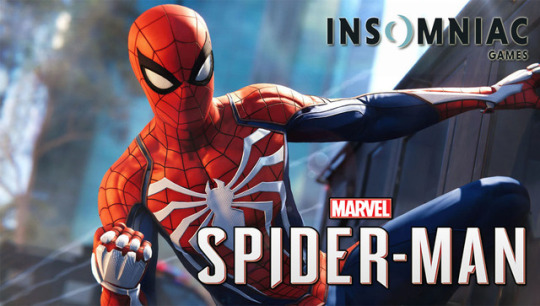
Spiderman for the PS4 is an incredible experience. It’s way different than any spiderman game out there. This game is the beginning of the next evolution of marvel turning their comic series into video games. This is what I wanted from Marvel the entire time; for them to create an incredible spiderman game that immerses you in story, fighting skills, and the best combos you have ever seen. It may take something from the Arkham series but it adds its own nuance and amazing web-slinging fun, and that’s what people want from Spider-Man. Web-slinging fun, taking villains seriously and, having the best villains. When you fight Shocker, when you fight the Sinister Six, and Mr. Negative (and find out who Mr. Negative is), everything comes together. If you are the type of person that’s not spoiled by trailers or don’t even watch a trailer or watch one second of a teaser, Spider-Man immerses you in an entire world full of ass-kicking, web-slinging, amazing characters and the story is just full of immerse-ness. You can grab onto the Spider-Man story and relate to every single comic, and there’s more mysteries within Spider-Man. There’s more that leads up to the stories of Spider-Man. When you’re going on a mission to collect back-pack pieces, everything for the back-pack, everything that he lost when he was in his younger years, has a story within it that you find. Including, a capsule that holds Sandman and that’s crazy and beautiful. It holds the essence and it holds Sandman. It may be a hint to other future games coming out from Insomniac games. This is the best moment for these characters and for the amazing Spider-Man himself, not just dealing with silver-sable, not just dealing with the backlash from kingpin. It’s the story coming out of there that’s incredible. Especially after the buildup of Doc Ock becoming evil and Spider-Man defeating him, as well as Peter’s relationship with Mary Jane and them getting back together. After playing Spider-Man and seeing the Spider-Verse, seeing characters, and finding out where they’re going next, you kind of get the connection between the two (game and movie). They’re amazing because you can see the suits, the costumes, and you get a bit of the story of Spiderman and Mary Jane. But, Peter in his adulthood trying to adult, and trying to hold down a job and pay his bills and his mortgage, it’s kind of hard to see him still struggle. It’s different seeing him going from the Daily Bugle to being a scientist and doing what he loves to do, something we don’t see often for his character. We also find out that his relationships with people are also kind of diminishing. I think in real life, we all go through the same struggles but this never makes Spider-Man selfish. Peter Parker is never selfish. And when they introduce Miles Morales, the selfishness is never displayed, it’s always “defend the people,” “for the people,” “do what’s right” and “don’t be selfish with anything.” That’s incredible coming from such an amazing character as Peter. And seeing the growth of Miles Morales before he loses his father in the game is even better because we’re taking a different look from the ultimate comic universe, in the video game. We get to see Miles, his hacking skills, and his relationship with his family. We see everything from the character up until the moment Mr. Negative attacks the town hall meeting with mayor Osbourne—and Miles’s dad dies. That is one of the hardest moments, because even Peter gets knocked out and we get to play as Miles for a moment and you get to use hacking scenarios with him. We also get to run from the rhino with Miles, and that is incredible. And then we also get to fight and punch up some guys with Miles for the first time. As the Spider-Man story progresses we see the growth of Miles when he gets his spider bite, we see the growth of the relationship between Peter and Doc Ock and how that relationship has failed, which is scary. We saw Doc Ock turning into a monster and turning into someone that was fueled by anger, deceit, destruction, and even when that deadly gas hit, Peter could have saved his aunt but he didn’t. And he had let his aunt die to save others. This is the most grueling part of the game, where Peter’s aunt passes away and now he has to take the mantle of an adult, he has to grow even further, he lost his aunt May and uncle Ben, and the only one he has left is Mary Jane by his side. Just going further in the story, finding out that Harry Osbourne is not on a trip in Europe, and he’s actually been held (willingly) in Oz Corp. behind secret doors. In the scene where MJ gets scared by a spider, Harry Osbourne is behind secret lab doors and at the end of the game, seeing that he’s surrounded by the venom symbiote, we get an aspect of the story that’s incredible because Norman Osbourne is using the symbiote to maybe try to cure Harry of the same disease his mother had, which is very emotional. The story layered is incredible and Insomniac games has pushed the envelope of what a Marvel and Spider-man game is. People say that there are many Spider-man games that have done the same thing. Not like this. Not story elements, not cinematic elements, nothing. From fighting all the enemies, to the story, to the hunts and the quests, you can never get bored with this game. You can never ever get bored with an incredible Spider-man game. There’s so many quests, there’s so many hunts, and there’s DLC that’s already out. If you haven’t played it, silver sable, hammerhead, black cat; 3 incredible DLC’s that are already out and people can’t wait for what’s next with the game, if there is anything. People can’t wait for part two. I can’t wait for part two. And that’s the thing, because we all want to know what’s gonna happen next. I hope they introduce Kraven the hunter and the Chameleon. I hope they introduce more aspects of Spider-man’s rouge gallery. And that’s another part about Spider-man that’s amazing. You can never stop wondering what they are gonna hint about in the comic, what comic are they going to hint, what movie are they going to hint to, what comics are they going to just throw out there, like “this is from this comic and that is from this issue.” As a Spider-man fan and a comic fan, anyone that buys this game knows there’s a lot of heart and soul that went into this. I thank the creators, I thank the producers, I thank the voice actors, I thank everyone that did every visual thing on this game, to the audience in New York City. I wish they had dialogue DLC so the dialogue could change up for the character and the emotes. But the web-slinging is incredible, the diving is amazing, the combat is smooth and sick and crazy. And the best part about taking pictures in New York City is that you can see Avengers Tower, you can explore and, the missions are just amazing. This is a solid Spider-man game, and whenever part two comes out, I hope it beats this one in sales and everything. And also that we get to choose from as many suits as possible. People love this game for the suits. If you’re a Spider-man fan, you should grab this game. You should cherish it forever, if you got the PS4, hold on to it. If you got the statue, you’re awesome. People may have invested a lot into this but it’s worth it. Every investment into a video game is worth it. Shout-out to the studios, thank you so much for creating an incredible game. I loved it. I can never stop playing it. I platinumed it and beat it, and I want the second one to be so hard that I can’t even reach a platinum. So, thank you Insomniac studios, thank you to the entire crew that worked on this game. So much awesomeness. A. Ringling
#spiderman#spidersona#new york city#marvel#marvelgaming#insomniac#amazing spider-man#spider punk#ghost spider#spider man 2099#spider man big time#spider man homecoming#spider man electro#rhino#spider man doc ock#spider man sam raimi#spider armor#infinity war suit#scarlet spider 2#scarlet spider#gaming#Spidermanfortheps4#spider-gwen#spider-verse#nyclife#sinister six#mary jane watson#we are venom#venom symbiote#harry osborn
1 note
·
View note
Text
Week 1 (Jan 6 - 13)
Hallo aus Berlin!!
I’m so excited to share with you what I've been up to the past week! It’s been pretty crazy getting adjusted to my new dorm, learning how to get around in Berlin, going to the store, and meeting new people. I can already tell I’m going to love Berlin and I’ve had such a great time so far. This post is so much longer than I anticipated, but I hope you enjoy reading about my first week!!
Last Sunday, I took one plane from Charlotte to London and then a short flight from London to Berlin. Everything went smoothly with with the flights and I got a few hours of sleep which was good! The meal I got on the plane was a pasta dish, which was pretty delicious. Here’s a picture of the airline meal and a picture of me with my suitcase for proof that I packed light!


I met up with some people in my same program who were on my flight from London to Berlin. Once I got to the Berlin airport, I met up with my roommate, who is also named Sarah, and then the program provided a bus that took us from the airport to the program center.
The place where I’m staying is a center for study abroad students from the US. The bottom section has a lobby and cafe and classrooms and then the top floors are the rooms where students live. My room is dorm style with bunk beds, a desk, a wardrobe, a mini-fridge/microwave set, and then a bathroom. Here are a few pictures!



The first day we were in Berlin we had a welcome toast to the semester, then we went on a short walking tour around the neighborhood, and then dinner with some people in the program.
One the second day, we had morning sessions that covered helpful information about our classes, the center, and the culture in Berlin. Then in the afternoon, we went on one of those bus tours of Berlin, which was cool because we saw the main tourist attractions (pictures below!) and learned about their history in addition to getting a better feel for the layout of the city. And by that I mean realizing just how big Berlin is!
The first stop was the East Side Gallery, which is the longest remaining piece of the Berlin Wall. After it was torn down, the city preserved this section and asked local artists to paint what peace and unity meant to them, so it’s covered in really cool murals. This picture is probably the most famous section - it depicts Leonid Brezhnez (Leader of the Soviet Union) and Erich Honecker (East Germany Leader) kissing and was based off of a photo taken when the German Democratic Republic (East Germany) was created.

Then we went to the Brandenburg Gate, which was pretty cool just because you see references to it everywhere in the city (including on the fabric in the seats in the U-Bahn) But the history of it is super cool - it’s actually pretty old (18th century) and was a part of the old Berlin Customs Wall, which was a literal wall around the city that regulated people to pay taxes on the goods they brought into and out of the city. The Brandenburg Gate was one of many gates in the wall, but it was used for people of higher nobility or special occasions. Then it was used later for triumphal processions by Napoleon and the Nazis.

The last stop was the Memorial to the Murdered Jews of Europe. It’s hard to get a good picture that shows the whole memorial because it’s so big, but it’s a large open space with grey concrete-looking boxes of various heights. There’s apparently a lot of controversy about this memorial, but the artist, Peter Eisenman, was also very intentional in his design. The monument resembles a cemetery and walking through the stone boxes makes you feel somewhat uncomfortable and trapped. Eisenman didn’t want to label the monument or label the boxes because he wanted viewers come to their own realization and form their own opinions about the meaning behind his work. The monument is one of the largest public spaces in Germany and was really moving. There’s also an underground documentation section, but we didn’t see that on our tour.

That night we went to a German/Austrian restaurant, and I had my first schnitzel of the semester! This was a veal schnitzel that is popular in Austria and it was incredible. I’ve also been trying different beers at restaurants because Berliners are obsessed with their beers.

P.S. the beer glass was smaller so don’t use it as a size comparison to the schnitzel which looks ginormous in this picture
On Wednesday we started our first day of class! I only had my International Finance class that day, but I think the class will be really interesting. The professor is also really awesome - he was discussing a concept in class and mentioned this tea beverage but no one in the class knew what he was talking about because it’s only made in Berlin, so during our break (they’re 10 minutes since the class the 3 hours) he went a bought one and had some plastic cups so we could all try it!
We also went to Real, which is kind of like Germany’s Walmart or Target. It was my first experience going on the U-Bahn (Berlin’s subway/metro) and to the store in Berlin and it was a wild experience. The U-Bahn is pretty simple, especially given my experience in New York, but it’s big and all the names of the stops have at least ten letters. At the store, they have a lot of the same brands as the United States, but it was definitely an experience. I just got some notebooks for class and other things that I didn’t want to worry about packing like a bigger shampoo bottle. The whole trip was a little overwhelming but my friends from the program were there too so we struggled together and are now laughing about how confused we were.
On Thursday, we went to the grocery store for the first time! It was super fun and we got stuff to make dinner and lunch since there is a communal kitchen at the center. I have a picture just because I was proud that we went and were cooking. Also, in the German grocery stores they only sell half loaves of bread and I think that’s genius. Also their cheese is way better than deli cheese from Harris Teeter.

It was also a slightly warmer and sunnier day, so we went for a walk around the neighborhood. The river was super beautiful and we also saw some interesting apartments too.


Afterwards, we went to a super cute cafe where we had some coffee and cherry cake.

On Friday, I don’t have any classes which means I got to spend a full day doing whatever I wanted! We went to this mall and got some more items that we needed and also just walked around to the different stores to see what they were like.
That afternoon we also went to the Berliner Dom, which is the big Cathedral in Berlin. It was super beautiful on the outside and it sits on what they call “Museum Island” because it’s an island in the middle of the Spree River that runs through Berlin and is where a lot of the main museums are. The inside is also really pretty and you can go to the top and see an awesome view of Berlin! It was foggy and dark outside when we were there but I’d like to go back when you can see more.





This is the view from the top! The TV Tower is to the left.
Also, a little bit of winter-y decorations were still up from Christmas and I thought they were really pretty!!


That night, we went to Curry 36, which they say at the program is a late-night staple. It’s a currywurst place, which is a fast-food dish consisting of sausage, French fries, curry-flavored ketchup, and mayonnaise. It is honestly life-changing and I would consider Curry36 similar to the Cookout of Berlin, which as many of you know is a pretty bold statement coming from me.

On Saturday, I went to an all-day German Survival Course that the program put on. It was somewhat helpful because we learned a little about ordering food and how to say some phrases. It’s definitely a hard language though so I can’t say that I have a large German vocabulary as of now.
Today (Sunday), we went to a brunch place and then a museum called Urban Nation, which is a contemporary art museum that focuses a lot on street art too. It was super cool.




And then tonight I’m just finishing up some homework!
Wow - it’s been a really busy week but I’ve loved being able to explore and experience new things, even if it was sometimes intimidating. Berlin seems like an amazing city and I’ve loved making new friends who are studying here with me too.
I miss you all!! Auf Wiedersehen!

the view from my dorm!
2 notes
·
View notes
Text
Marvel’s Spider-Man: Miles Morales Ending Explained
https://ift.tt/35qd0Yx
This Marvel’s Spider-Man: Miles Morales article contains spoilers.
Marvel’s Spider-Man: Miles Morales ends in notably epic fashion considering the deeply personal story at its heart. Most of the game focuses on the conflict between Miles Morales and his best friend Phin Mason, whom he discovers is the villain known as the Tinkerer, the leader of a terrorist group known as the Undeground that has been waging war against the shady Roxxon Energy corporation on New York’s City streets.
Phin’s out for revenge on Roxxon for the death of her brother Rick, and Miles, who has been left to protect the city while Peter’s away in Europe, finds himself stuck right in the middle. He’s forced to stop Phin at all costs before she can blow up Harlem by exploiting Roxxon’s NuForm energy, which is what killed her brother.
This all leads to an explosive confrontation between Miles and Phin that will likely shape the young hero’s crime-fighting career for years to come. Miles’ latest test as a new Spider-Man turns out to be pretty life-altering.
Let’s break down what happened in the game’s final moments:
What happens between Miles and Phin?
When Miles confronts Phin at Roxxon Plaza, which she plans to demolish by overloading a NuForm reactor, he tries to explain to her that Roxxon scientist and criminal mastermind Simon Krieger tampered with the reactor and that the explosion will cause far more damage to the surrounding neighborhood, killing thousands of people in Harlem.
But Phin is overcome with rage and resentment, still reeling from the death of her engineer brother, who lost his life trying to eradicate NuForm, which he invented but subsequently discovered made people sick. She also doesn’t trust Miles after he lied to her about wanting to join her in the Underground all while withholding the fact that he’s been trying to thwart her plans as Spider-Man all along.
They’re at an impasse: Phin is deadset on avenging her brother and Miles vows to stop her to protect his city. They come to blows high above the Harlem streets and Phin gets the best of Miles as the energy converter pulsates and threatens to destroy everything around it. But amid the chaos she glimpses the faces of the New Yorkers down below, running terrified as the volatile reactor sends tremors down the city streets.
Eventually, she loses her footing and plummets to the ground below. Miles saves her (taking off his faulty tech mask in the process), but they crash land mere feet away from the crackling reactor.
How does Miles save the day?
When Miles comes to, he stumbles toward the overloaded NuForm reactor to shut it down with his electricity-based Venom Power. He is successful but can’t hold in all of the energy he’s absorbed for long.
Phin comes to her senses and decides to grab Miles, run up the side of the towering Roxxon building with her Underground tech-powered boots, and rocket high into the night sky. She tells Miles to “let go,” which he does, resulting in a giant explosion that evidently vaporizes Phin and sends an unconscious Miles hurtling toward the earth below. He crash lands AGAIN, this time unmasked for all onlookers to see.
The fact that Phin ultimately uses the technology she developed not to take Roxxon, but to literally “go high” and save lives while paying for her own wrongdoings with her own life, is a poetic exclamation point at the end of an intensely personal story.
What happens now that Miles has been unmasked?
A few civilians—including his best friend Ganke, his mother Rio, Spidey ally Hailey, and the artist responsible for the Spider-Man mural outside Miles’s apartment building—discover Miles’ secret identity. A news reporter arrives as Miles flees the scene and asks the bystanders if they saw his face. They refuse to identify him and instead refer to him as “Our Spider-Man,” a refrain among the citizens of Harlem throughout the game. It seems as if his secret identity will remain safe for now.
This moment underlines one of the story’s main themes — that underrepresented, marginalized people deserve a hero they can call their own. They protect Miles’s identity because they know he’s one of them—he’s from THEIR neighborhood.
What happens to Uncle Aaron/The Prowler and Simon Krieg?
Four weeks after the incident at Roxxon Plaza, it’s revealed via radio host Danika that Uncle Aaron, also known as the Prowler, who briefly worked with Simon Krieger, flipped on his former associate, sending the evil CEO to prison in embarrassing fashion. He’ll do time himself but may get a reduced sentence. Like Phin, he’ll pay for his mistakes, but has also started to redeem himself in the process.
Read more
Games
Spider-Man: Miles Morales Suit Has Us Dreaming of An Into the Spider-Verse Game
By Matthew Byrd
Games
Marvel’s Spider-Man Miles Morales: Spider-Cat Twitter Reactions and Memes Are Amazing
By John Saavedra
Where do Miles and Peter stand?
By the end of the game, Miles has finally started to feel comfortable in his role as Harlem’s very own Spider-Man. We see him in a good mood, strutting down his block, flirting with Hailey underneath the Spider-Man mural (which now features his masked likeness in addition to Peter’s), and stopping for a quick bachata dance in his Timbs with an old lady before ducking into his apartment building.
We then see Miles meet with Peter, who’s back from Europe, on his apartment building’s roof. Miles is wearing his new suit (updated with a slick hoodie), which Peter approves of. “Gotta be me,” says Miles as he casually sips coffee while hanging upside down, a nod to a moment between the two heroes at the start of the game that signifies he finally feels ready to be the hero he was meant to be. More importantly, he’s ready to be his true self.
“Roxxon did this uptown because they saw us as disposable,” Miles somberly explains to Peter. “I think part of our job is making sure they can’t get away with it.” This is a poignant moment that hits again on the idea that New York’s POC communities deserve heroes that represent them.
Why is Harry Osborn in that vat?
After the game’s credits, we cut to none other than Harry Osborne floating in a vat of murky green liquid. He sees his father, Norman, enter the lab he’s being held in and get an update on his recovery from the Lizard himself, scientist Curt Connors. Norman says that he wants his son out of the vat now, but Connors advises against this, citing Harry’s dangerous “disease,” but Norman is insistent.
This is actually the continuation of a story whose seed was planted in the original game, in which Peter conducted research for Harry across New York while he was handling Oscorp business “overseas.” In reality, Harry was sick the entire time, and the game’s deadly “Devil’s Breath” concoction was a failed attempt by Norman to cure him. In a short scene in the game, Norman vows to find a cure that actually works.
Now it seems that Norman has finally found a way to release Harry from his emerald cocoon, and this surely means we’ll be seeing Harry and Norman featured front and center in the inevitable Marvel’s Spider-Man sequel, with Harry suffering from side-effects from his treatment that turn him into the Green Goblin.
It’s also notable that in the scene we hear on the radio that Rio Morales’s campaign for city council was successful, which could mean Rio will play an even bigger role in the Spider-Man story to come.
What did Miles learn from his mom?
When all of the end game cinematics are through, we see Miles set down the science award he and Phin won together in middle school atop Trinity Church, as he says his final goodbye to his old friend.
He then shares a conversation with Rio on the phone and they discuss his feelings about Phin. He says he’s conflicted about his feelings for his late friend because she caused so much damage but also ultimately gave her life to save others. She tells him that he doesn’t have to pass judgment on Phin’s life but simply remember why he loved her.
cnx.cmd.push(function() { cnx({ playerId: "106e33c0-3911-473c-b599-b1426db57530", }).render("0270c398a82f44f49c23c16122516796"); });
It’s a powerful note to end the story on, as Rio touches on the idea that people don’t simply fall into the categories of “good” or “bad.” This is a story about forgiveness and empathy, and no character exemplifies this more than Rio.
Marvel’s Spider-Man: Miles Morales is out on PlayStation 5 and PlayStation 4 now.
The post Marvel’s Spider-Man: Miles Morales Ending Explained appeared first on Den of Geek.
from Den of Geek https://ift.tt/2JWJeCw
0 notes
Text
Mahalia Jackson

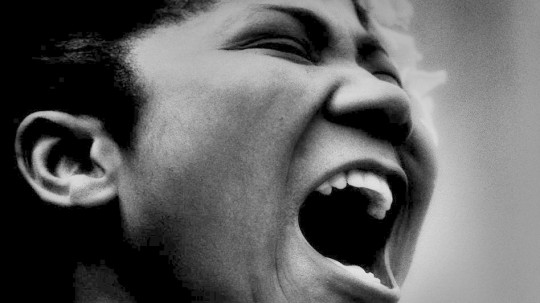
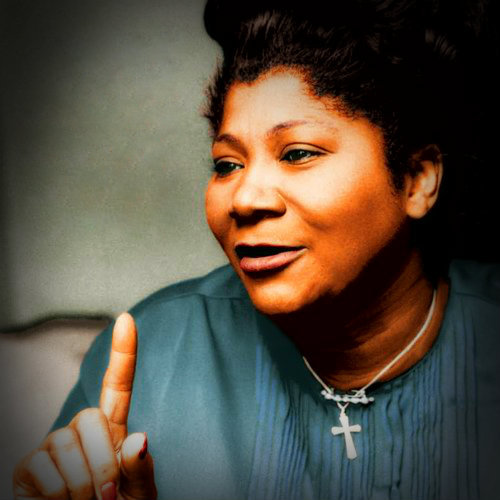

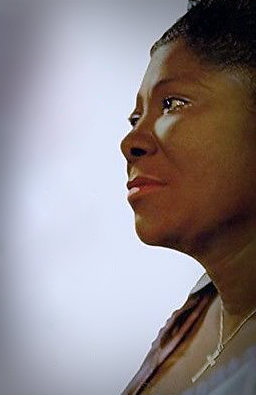

Mahalia Jackson (/məˈheɪljə/ mə-HAYL-yə; October 26, 1911 – January 27, 1972) was an American gospel singer. Possessing a powerful contralto voice, she was referred to as "The Queen of Gospel". She became one of the most influential gospel singers in the world and was heralded internationally as a singer and civil rights activist. She was described by entertainer Harry Belafonte as "the single most powerful black woman in the United States". She recorded about 30 albums (mostly for Columbia Records) during her career, and her 45 rpm records included a dozen "golds"—million-sellers.
"I sing God's music because it makes me feel free", Jackson once said about her choice of gospel, adding, "It gives me hope. With the blues, when you finish, you still have the blues."
Early life
She was born on October 26, 1911 as Mahala Jackson and nicknamed "Halie". Jackson grew up in the Black Pearl section of the Carrollton neighborhood of uptown New Orleans. The three-room dwelling on Pitt Street housed thirteen people and a dog. This included Little Mahala (named after her aunt, Mahala Clark-Paul whom the family called Aunt Duke); her brother Roosevelt Hunter, whom they called Peter; and her mother Charity Clark, who worked as both a maid and a laundress. Several aunts and cousins lived in the house as well. Aunt Mahala was given the nickname "Duke" after proving herself the undisputed "boss" of the family. The extended family (the Clarks) consisted of her mother's siblings: Isabell, Mahala, Boston, Porterfield, Hannah, Alice, Rhoda, Bessie, their children, grandchildren, and patriarch Rev. Paul Clark, a former slave. Jackson's father, John A. Jackson, Sr. was a stevedore (dockworker) and a barber who later became a Baptist minister. He fathered five other children besides Mahalia: Wilmon (older) and then Yvonne, Edna, Pearl, and Johnny, Jr. (by his marriage shortly after Halie's birth). Her father's sister, Jeanette Jackson-Burnett, and her husband, Josie, were vaudeville entertainers. Their son, her cousin Edward, shared stories and records of Ma Rainey, Mamie Smith, and Bessie Smith whose voices and blues singing impressed her so much that she would imitate their ways of bending and coloring notes. (Her voice and singing style would be compared to Bessie Smith's all her life).
At birth, Jackson suffered from genu varum, or "bowed legs". The doctors wanted to perform surgery by breaking her legs, but one of the resident aunts opposed it. Jackson's mother would rub her legs down with greasy dishwater. The condition never stopped young Jackson from performing her dance steps for the white woman for whom her mother and Aunt Bell cleaned house.
Jackson was four (or five) years old when her mother Charity died (at the age of 25), leaving her family to decide who would raise Halie and her brother. Aunt Duke assumed this responsibility, and the children were forced to work from sun-up to sun-down. Aunt Duke would always inspect the house using the "white glove" method. If the house was not cleaned properly, Jackson was beaten. If one of the other relatives could not do their chores or clean at their job, Jackson or one of her cousins was expected to perform that particular task. School was hardly an option. Jackson loved to sing and church is where she loved to sing the most. Her Aunt Bell told her that one day she would sing in front of royalty, a prediction that would eventually come true. Jackson began her singing career at the local Mount Moriah Baptist Church. At 12 years old, she was baptized in the Mississippi River by Mt. Moriah's pastor, the Rev. E.D. Lawrence, then went back to the church to "receive the right hand of fellowship".
Career
1920s–1940s
In 1927, at the age of 16, Jackson moved to Chicago, Illinois, in the midst of the Great Migration. After her first Sunday school service, where she had given an impromptu performance of her favorite song, "Hand Me Down My Silver Trumpet, Gabriel", she was invited to join the Greater Salem Baptist Church Choir. She began touring the city's churches and surrounding areas with the Johnson Gospel Singers, one of the earliest professional gospel groups. In 1929, Jackson met the composer Thomas A. Dorsey, known as the Father of Gospel Music. He gave her musical advice, and in the mid-1930s they began a 14-year association of touring, with Jackson singing Dorsey's songs in church programs and at conventions. His "Take My Hand, Precious Lord" became her signature song.
In 1936, Jackson married Isaac Lanes Grey Hockenhull ("Ike"), a graduate of Fisk University and Tuskegee Institute who was 10 years her senior. She refused to sing secular music, a pledge she would keep throughout her professional life. She was frequently offered money to do so and she divorced Isaac in 1941 because of his unrelenting pressure on her to sing secular music and his addiction to gambling on racehorses.
In 1931, Jackson recorded "You Better Run, Run, Run". Not much is known about this recording and no publicly known copies exist. Biographer Laurraine Goreau cites that it was also around this time she added the "i" to her name, changing it from Mahala to Mahalia, pronounced /məˈheɪliə/. At the age of 25, her second set of records was recorded on May 21, 1937, under the Decca Coral label, accompanied by Estelle Allen (piano), in order: "God's Gonna Separate The Wheat From The Tares", "My Lord", "Keep Me Everyday" and "God Shall Wipe All Tears Away". Financially, these were not successful, and Decca let her go.
In 1947, Jackson signed up with the Apollo label, and in 1948, recorded the William Herbert Brewster song "Move On Up a Little Higher", a recording so popular stores could not stock enough copies to meet demand, selling an astonishing eight million copies. (The song was later honored with the Grammy Hall of Fame Award in 1998.) The success of this record rocketed her to fame in the U.S., and soon after, in Europe. During this time she toured as a concert artist, appearing more frequently in concert halls and less often in churches. As a consequence of this change in her venues, her arrangements expanded from piano and organ to orchestral accompaniments.
Other recordings received wide praise, including "Let the Power of the Holy Ghost Fall on Me" (1949), which won the French Academy's Grand Prix du Disque; and "Silent Night", which became one of the best-selling singles in the history of Norway. When Jackson sang "Silent Night" on Denmark's national radio, more than 20,000 requests for copies poured in. Other recordings on the Apollo label included "He Knows My Heart" (1946), "Amazing Grace" (1947), "Tired" (1947), "I Can Put My Trust in Jesus" (1949), "Walk with Me" (1949), "Let the Power of the Holy Ghost Fall on Me" (1949), "Go Tell It on the Mountain" (1950), "The Lord's Prayer" (1950), "How I Got Over" (1951), "His Eye Is on the Sparrow" (1951), "I Believe" (1953), "Didn't It Rain" (1953), "Hands of God" (1953) and "Nobody Knows" (1954).
1950s–1970s
In 1950, Jackson became the first gospel singer to perform at Carnegie Hall when Joe Bostic produced the Negro Gospel and Religious Music Festival. She started touring Europe in 1952 and was hailed by critics as the "world's greatest gospel singer". In Paris she was called the Angel of Peace, and throughout the continent she sang to capacity audiences. The tour, however, had to be cut short due to exhaustion. She began a radio series on CBS and signed to Columbia Records in 1954. A writer for Down Beat music magazine stated on November 17, 1954: "It is generally agreed that the greatest spiritual singer now alive is Mahalia Jackson." Her debut album for Columbia was The World's Greatest Gospel Singer, recorded in 1954, followed by a Christmas album called Sweet Little Jesus Boy and Bless This House in 1956.
With her mainstream success, Jackson was criticized by some gospel purists who complained about her hand-clapping and foot-stomping and about her bringing "jazz into the church". She had many notable accomplishments during this period, including her performance of many songs in the 1958 film St. Louis Blues, singing "Trouble of the World" in 1959's Imitation of Life, and recording with Percy Faith. When she recorded The Power and the Glory with Faith, the orchestra arched their bows to honor her in solemn recognition of her great voice. She was the main attraction in the first gospel music showcase at the Newport Jazz Festival in 1957, which was organized by Joe Bostic and recorded by the Voice of America and performed again in 1958 (Newport 1958). She was also present at the opening night of Chicago's Old Town School of Folk Music in December 1957. In 1961, she sang at John F. Kennedy's inaugural ball. She recorded her second Christmas album Silent Night (Songs for Christmas) in 1962. By this time, she had also become a familiar face to British television viewers as a result of short films of her performing that were occasionally shown.
At the March on Washington in 1963, Jackson sang in front of 250,000 people "How I Got Over" and "I Been 'Buked and I Been Scorned". Martin Luther King, Jr. made his famous "I Have a Dream" speech there. She also sang "Take My Hand, Precious Lord" at his funeral after he was assassinated in 1968. She sang to crowds at the 1964 New York World's Fair and was accompanied by "wonderboy preacher" Al Sharpton. She toured Europe again in 1961 (Recorded Live in Europe 1961), 1963–64, 1967, 1968 and 1969. In 1970, she performed for Liberian President William Tubman.
Jackson's last album was What The World Needs Now (1969). The next year, in 1970, she and Louis Armstrong performed "Just a Closer Walk with Thee" and "When the Saints Go Marching In" together. She ended her career in 1971 with a concert in Germany, and when she returned to the U.S., made one of her final television appearances on The Flip Wilson Show. She devoted much of her time and energy to helping others. She established the Mahalia Jackson Scholarship Foundation for young people who wanted to attend college. For her efforts in helping international understanding, she received the Silver Dove Award. Chicago remained her home until the end. She opened a beauty parlor and a florist shop with her earnings, while also investing in real estate ($100,000 a year at her peak).
In 1970, she guest-starred on episode 56 of Sesame Street, singing "He's Got the Whole World in His Hands", followed by Gordon Robinson (played by Matt Robinson) finding hidden E's.
Civil rights movement
Jackson played an important role during the civil rights movement. In August 1956, she met Ralph Abernathy and Martin Luther King, Jr. at the National Baptist Convention. A few months later, both King and Abernathy contacted her about coming to Montgomery, Alabama, to sing at a rally to raise money for the bus boycott. They also hoped she would inspire the people who were getting discouraged with the boycott.
Despite death threats, Jackson agreed to sing in Montgomery. Her concert was on December 6, 1956. By then, the U.S. Supreme Court had ruled in Browder v. Gayle that bus segregation was unconstitutional. In Montgomery, the ruling was not yet put into effect, so the bus boycott continued. At this concert she sang "I've Heard of a City Called Heaven", "Move On Up a Little Higher" and "Silent Night". There was a good turnout at the concert and they were happy with the amount of money raised. However, when she returned to the Abernathy's home, it had been bombed. The boycott finally ended on December 21, 1956, when federal injunctions were served, forcing Montgomery to comply with the court ruling.
Although Jackson was internationally known and had moved up to the northern states, she still encountered racial prejudice. One account of this was when she tried to buy a house in Chicago. Everywhere she went, the white owners and real estate agents would turn her away, claiming the house had already been sold or they changed their minds about selling. When she finally found a house, the neighbors were not happy. Shots were fired at her windows and she had to contact the police for protection. White families started moving out and black families started moving in. Everything remained the same in her neighborhood except for the skin color of the residents.
King and Abernathy continued to protest segregation. In 1957, they founded the Southern Christian Leadership Conference (SCLC). The first major event sponsored by the SCLC was the Prayer Pilgrimage for Freedom in Washington, D.C., on May 17, 1957, the third anniversary of the Brown v. Board of Education decision. From this point forward, Jackson appeared often with King, singing before his speeches and for SCLC fundraisers. In a 1962 SCLC press release, he wrote she had "appeared on numerous programs that helped the struggle in the South, but now she has indicated that she wants to be involved on a regular basis". Jesse Jackson said when King called on her, she never refused, traveling with him to the deepest parts of the segregated South.
At the March on Washington for Jobs and Freedom in 1963, Jackson performed "I Been 'Buked and I Been Scorned", before King gave his "I Have a Dream" speech. Toward the end of the speech, he departed from his prepared text for a partly improvised peroration on the theme "I have a dream", prompted by Jackson's cry: "Tell them about the dream, Martin!"
Jackson said that she hoped her music could "break down some of the hate and fear that divide the white and black people in this country". She also contributed financially to the movement.
Death
Jackson died in Chicago on January 27, 1972 at Little Company of Mary Hospital in Evergreen Park, Illinois, of heart failure and diabetes complications. Two cities paid tribute: Chicago and New Orleans. Beginning in Chicago, outside the Greater Salem Baptist Church, 50,000 people filed silently past her mahogany, glass-topped coffin in final tribute to the queen of gospel song. The next day, as many people who could—6,000 or more—filled every seat and stood along the walls of the city's public concert hall, the Arie Crown Theater of McCormick Place, for a two-hour funeral service. Her pastor, Rev. Leon Jenkins, Mayor Richard J. Daley, and Mrs. Coretta Scott King eulogized her during the Chicago funeral as "a friend – proud, black and beautiful". Sammy Davis, Jr., and Ella Fitzgerald paid their respects. Joseph H. Jackson, president of the National Baptist Convention, U.S.A., Inc., delivered the eulogy at the Chicago funeral. Aretha Franklin closed the Chicago rites with a moving rendition of "Precious Lord, Take My Hand".
Three days later, a thousand miles away, the scene repeated itself: again the long lines, again the silent tribute, again the thousands filling the great hall of the Rivergate Convention Center in downtown New Orleans this time. Mayor Moon Landrieu and Louisiana Governor John J. McKeithen joined gospel singer Bessie Griffin. Dick Gregory praised Jackson's "moral force" as the main reason for her success. Lou Rawls sang "Just a Closer Walk With Thee". The funeral cortège of 24 limousines drove slowly past her childhood place of worship, Mt. Moriah Baptist Church, where her recordings played through loudspeakers. The procession made its way to Providence Memorial Park in Metairie, Louisiana, where she was entombed. Despite the inscription of her birth year on her gravestone as 1912, she was actually born in 1911. Among her surviving relatives are her great-nephews, NBA basketball player Danny Granger and soul artist Scotty Granger.
Jackson's estate was reported at more than four million dollars. Some reporters estimated record royalties, television and movie residuals, and various investments made it worth more. The bulk of the estate was left to a number of relatives, many of whom cared for her during her early years. Among principal heirs were relatives including her half-brother, John Jackson, and aunt, Hannah Robinson. Neither of her ex-husbands, Isaac Hockenhull (1936–1941) and Sigmund Galloway (1964–1967), were mentioned in her will.
Legacy and honors
Jackson's music was played widely on gospel and Christian radio stations, such as Family Radio. Her good friend Martin Luther King, Jr., said, "A voice like this one comes not once in a century, but once in a millennium." She was a close friend of Doris Akers, one of the most prolific gospel composers of the 20th century. In 1958, they cowrote the hit "Lord, Don't Move the Mountain". Mahalia also sang many of Akers' own compositions such as "God Is So Good to Me", "God Spoke to Me One Day", "Trouble", "Lead On, Lord Jesus" and "He's a Light Unto My Pathway", helping Akers to secure her position as the leading female Gospel composer of that time. In addition to her singing career, she mentored the legendary soul singer Aretha Franklin. Jackson was also good friends with Dorothy Norwood and fellow Chicago-based gospel singer Albertina Walker, and she discovered a young Della Reese. On the 20th anniversary of her death, Smithsonian Folkways Recording commemorated her with the album I Sing Because I'm Happy, which includes interviews about her childhood conducted by Jules Scherwin.
American Idol winner and Grammy Award-winning R&B singer Fantasia Barrino has been cast to play Jackson in a biographical film about her life. It will be based on the 1993 book Got to Tell It: Mahalia Jackson, Queen of Gospel. It is said to be directed by Euzhan Palcy, according to The Hollywood Reporter.
The National Academy of Recording Arts & Sciences created the Gospel Music or Other Religious Recording category for Jackson, making her the first gospel music artist to win the prestigious Grammy Award.
In December 2008, she was inducted into The Louisiana Music Hall of Fame.
A prominent namesake in her native New Orleans is the Mahalia Jackson Theater of the Performing Arts, which was remodeled and reopened on January 17, 2009, with a gala ceremony featuring Plácido Domingo, Patricia Clarkson, and the New Orleans Opera directed by Robert Lyall.
Mahalia Jackson was inducted as a Laureate of The Lincoln Academy of Illinois and awarded the Order of Lincoln (the State’s highest honor) by the Governor of Illinois in 1967 in the area of The Performing Arts.
Selective awards and honors
Grammy Award historyGrammy Hall of Fame
Jackson was posthumously inducted into the Grammy Hall of Fame, a special Grammy award established in 1973 to honor artists whose recordings are at least twenty-five years old and have "qualitative or historical significance". Jackson is a three-time inductee as of 2015.
Honors
Well-known songs
In popular culture
Jackson appears in the 1960 film Jazz on a Summer's Day – an artistic documentary filmed at the 1958 Newport Jazz Festival. She sings three gospel numbers at the end of the film, including "The Lord's Prayer".
In the 1958 movie St. Louis Blues, Jackson played the character Bessie May and sang in the church choir.
In the movie Jungle Fever, the character played by Ossie Davis tries to distract himself from his son Gator's (Samuel L. Jackson) crack cocaine addiction by listening to her albums by the hour.
In the 1959 film Imitation of Life, Jackson portrays the choir soloist, singing "Trouble of the World" at Annie's funeral. She has no speaking lines, but her singing performance highlights the climactic scene.
In the 1964 film The Best Man, Jackson plays herself, singing at a Democratic Convention in a two-minute clip.
In the television promotional special This Way to Sesame Street, Ernie mentions Jackson as one of the celebrities who occasionally visit Sesame Street.
Duke Ellington, with whom Jackson occasionally recorded, most notably on the studio version of Black, Brown and Beige, paid tribute to her on his New Orleans Suite album with the song "Portrait of Mahalia Jackson".
In the 1970 documentary movie Elvis: That's the Way It Is, Elvis Presley jokes with one of his back-up singing groups The Sweet Inspirations that, "I'm gonna bring in the Supremes tomorrow night, you know. And Mahalia Jackson singing lead with them."
Alan Parker's 1988 film Mississippi Burning starts with Jackson's famous recording of "Take My Hand, Precious Lord" over the opening credits, over a poignant scene of a pair of segregated water fountains.
In the 2014 film Selma, she is portrayed by singer Ledisi.
Columbia Records discography
World's Greatest Gospel Singer
Sweet Little Jesus Boy
Bless This House
You'll Never Walk Alone
Gospels, Spirituals, & Hymns (1956)
Live at Newport 1958
Great Gettin' Up Morning
Come On Children, Let's Sing
The Power and the Glory
I Believe
Everytime I Feel the Spirit
Recorded Live in Europe During Her Latest Concert Tour
Great Songs of Love and Faith
Make a Joyful Noise Unto the Lord
Silent Night
Mahalia Jackson's Greatest Hits
Let's Pray Together
Mahalia
Garden of Prayer
My Faith
Mahalia Jackson in Concert Easter Sunday, 1967
A Mighty Fortress
Christmas With Mahalia
Mahalia Sings the Gospel Right Out of the Church
What the World Needs Now
Compilations
Nobody Knows the Trouble I've Seen (1975) Vogue
The Best of Mahalia Jackson Hymns, Spirituals & Songs of Inspiration (1976)
Mahalia Jackson's Greatest Hits (1988) Columbia Records
Mahalia Jackson: The Apollo Sessions 1946–1951 (re-issued 1994) Pair Records
The Forgotten Recordings (2005) Acrobat
Wikipedia
10 notes
·
View notes
Note
I saw on your Twitter about your love of Spider-Man ships, and I was wondering if you could expand on them? I know about Peter/MJ and Peter/Gwen, but that's about it. (And maybe Peter/Liz? Idk if that's just an MCU thing or not.)
I love, love, love the women of Spider-Man and I think 616Spider-Man has some of the best love stories and some of the best romanticchemistry in comics. PeterGwen and PeterMJ are the big ones, along withPeterFelicia, but he’s had a number of relationships over the years – CissieIronwood (Marvel Team Up vol1 #80-81, #90, Annual #2), Marcy Kane, Deb Whitman,an implied casual hookup with his neighbor Bambi, a thing with his work wife,reporter Joy Mercado – okay this one didn’t actually happen-happen,but it happened in my heart, and they did kiss. I love her and will refer toher as his work wife forever. But let’s start at the beginning, since you askedabout Liz Allan. PeterMJ and PeterGwen are considered the big Spider-Man lovetriangle, but Peter was involved in plenty of romantic drama before either MaryJane or Gwen was ever introduced on the page. One of the big things I loveabout Spider-Man are how, even after the romantic relationships are over, theseries lets its female characters continue to have big roles in Peter Parker’slife, and that’s the case with both Betty Brant and Liz Allan, the leadingladies of the original Spider-Man love triangle. PeterLiz is athing, although it’s very different from the way the MCU portrayed it, so let’sstart there.
Liz Allan: Liz is one of the longest running Spider-Mancharacters and one of the few to debut in Amazing Fantasy #15 along with Peterhimself, Flash Thompson, Aunt May and Uncle Ben. While Peter initially had acrush on Liz, who was at the time dating Flash Thompson (everyone in theSpider-Man friend group has dated everyone at one point or another), Peter soongot over it when he met J Jonah Jameson’s secretary Betty Brant – only for Lizto develop a crush on Peter after. She openly flirted with him, causingtensions between Peter and Betty and Peter and Flash both.

(Amazing Spider-Man #17)
Liz faded out of the picture for a bit after confessing her feelings to Peter at their high school graduation in Amazing Spider-Man #28, only to make her return in Amazing Spider-Man #132, when Peter encounters her wandering the streets exhausted and troubled over her step-brother, Max Raxton, the Molten Man, a one-time supervillain who would later reform.

Liz later met Harry Osborn at Betty Brant’s wedding and the two quickly fell in love and got married. (Everyone in Spider-Man has been involved with everyone in Spider-Man.) They have one son together, Norman Osborn Jr. They probably should have thought on that name a little more. (Harry has a second child with a woman named Lily Hollister.)

(Amazing Spider-Man Annual #17 – everyone in Spider-Man has also made out with everyone in Spider-Man, regardless of relationship status.)
Peter and Mary Jane even lived in the same building as Liz and Harry for a while, up until Harry’s death (long story – he got better). Liz took over Oscorp in the wake of Harry’s death, briefly had a relationship with Daredevil’s Foggy Nelson, and eventually became CEO of Alchemax. Recently, she and Harry got back together in Amazing Spider-Man #789.
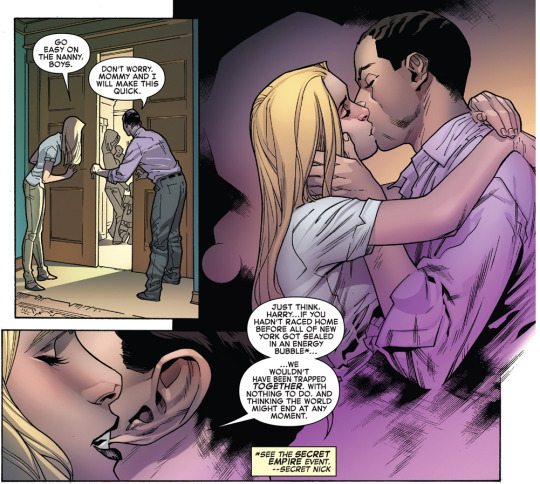
Some Liz issues:
Amazing Spider-Man #1-28: Liz has moments scattered all through the high school years, including ASM #6, where she develops a crush on Spider-Man, ASM #17, where she schemes to get Peter to attend a meeting of the Spider-Man fan club, ASM #25 when she first meets Mary Jane, ASM #26 where she breaks up a fight between Peter and Flash, and ASM #28 where she confesses her feelings for Peter.
Webspinners #9: A more modern Spider-Man high school flashback, Peter finds himself in trouble when he accidentally ends up with both Liz and Betty believing they’re going to prom with him. An excellent look at how smothered and trapped Liz felt as a teenager.
Amazing Spider-Man #132-133: Liz makes her reappearance.
Amazing Spider-Man #153: Liz asks Harry out, starting their relationship.
Amazing Spider-Man#166: Liz and Harry announce they’re getting married.
Amazing Spider-Man #172-180: When Liz is arrested for attempted robbery, she temporarily leaves Harry, believing herself no good for him.
Spectacular Spider-Man #85: Liz announces she’s pregnant.
Amazing Spider-Man #260-263: Mary Jane and a heavily pregnant Liz are kidnapped. Harry, in an attempt to rescue them, ends up captured as well. Later, Liz gives birth to her and Harry’s son.
Spectacular Spider-Man #178-184, #189-190, #200, #204: The Child Within/The Harry Osborn Saga. Haunted by his father’s evil legacy and poisoned by the belief that Peter killed his father, Harry spirals back into the Green Goblin and Liz’s family falls apart. The Child Within (Spectacular Spider-Man #178-184) is one of my favorite storylines of all time, a truly haunting read. Content warning for childhood abuse, including childhood sexual abuse, not of Harry but definitely paralleled against Norman’s abuse of Harry. In #189-190, Harry kidnaps Liz, Normie, and Liz’s stepbrother Mark. Spectacular Spider-Man #200 is the death of Harry Osborn, and in my personal opinion one of if not THE most stunning comic book issue of all time. In #204, Liz and friends receive Harry’s video will.
Peter Parker #75: Norman Osborn returns from the dead and threatens Liz. Also has some good Liz&Flash content.
Marvel Knights Spider-Man #7: Peter and Liz attend Midtown High’s reunion.
Amazing Spider-Man #581-582: Harry Osborn, returned from the dead, attempts to right some wrongs for Liz.
Amazing Spider-Man #789, #799-800: Liz and Harry rekindle their romance, only to have their children kidnapped. Cards on the table: I hate this story arc and think it’s terrible! But I do love every panel with Liz in it, so, that’s the toss up.
Liz has also made some recent appearances in Eddie Brock’s Venom series.
Betty Brant: Like Liz, Betty’s one of the longest running Spider-Man cast members. The title of Spider-Man’s first girlfriend is commonly and erroneously granted to Gwen Stacy, but Peter actually first dated Betty Brant in 616. First appearing in Amazing Spider-Man #4, Betty worked as J Jonah Jameson’s secretary and she and Peter quickly became close.
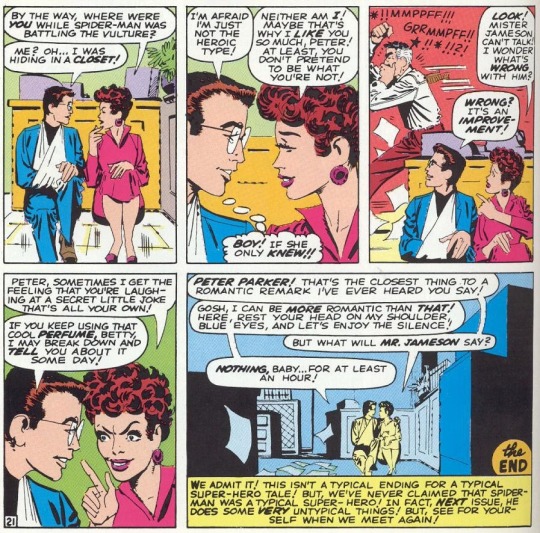
(Amazing Spider-Man #7 – another common error is assuming Peter’s always been awkward/shy around girls. “Nothing, baby… for at least an hour!” Smooth.)
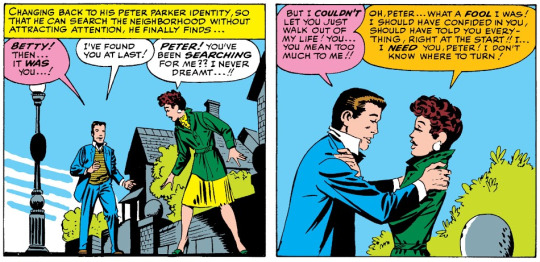
(Amazing Spider-Man #11)
Betty and Peter’s relationship wasn’t without its own issues, though. Betty was jealous of Liz’s flirtations with Peter, but things really came to a head when her brother, Bennett Brant, was murdered. Betty blamed Spider-Man for his death, and Peter felt that this meant he could never tell her his secret identity. They still continued the relationship, complicated by the appearance of Ned Leeds, a reporter for the Daily Bugle who was also interested in Betty. Though she loved Peter more, Ned seemed to offer Betty the stability she craved. After his high school graduation, Peter planned to propose to Betty (yes, at age eighteen, with a part time job, and still living in his aunt’s home, he planned to propose, because Peter Parker LOVES proposing) but things didn’t go as planned.

(Amazing Spider-Man #30)
After a long engagement, Betty finally married Ned Leeds in Amazing Spider-Man #156. The two left for France, where Ned was on assignment. Ned worked long hours and Betty found herself completely isolated, alone in a country where she didn’t speak the language. She left Ned and returned to New York, where her and Peter’s feelings for each other were rekindled.
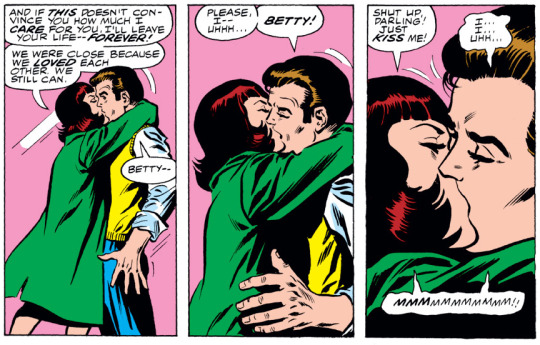

(Amazing Spider-Man #189)
Peter and Betty’s affair was short-lived after Ned returned. While he and Betty attempted to reconcile their marriage, it continued to deteriorate, and Betty sought comfort in Flash Thompson, who had at this point become one of Peter’s closest friends. The two would have an on-again, off-again relationship for years, and through it all Betty’s remained one of Peter’s most important relationships.
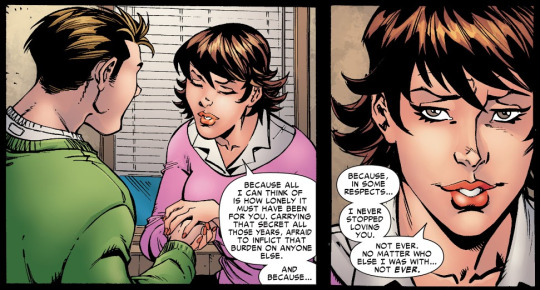
(Friendly Neighborhood Spider-Man #20)
Some Betty issues:
Amazing Spider-Man #4: Betty’s first appearance.
Amazing Spider-Man #7: Peter and Betty begintheir romance.
Amazing Spider-Man #10-11: When Betty disappearsfrom town, Peter goes after her – only for Spider-Man to become embroiled in anincident that leads to the death of her older brother, Bennett.
Untold Tales of Spider-Man #12: Betty’s backstoryrevealed, including the details of the relationship she had before Peter, andwhy his thrill-seeking disturbed her so deeply.
Amazing Spider-Man #30: Betty reveals that NedLeeds has proposed to her, and Peter plans to propose to her himself, only forthe shadow of Spider-Man to come between them.
Amazing Spider-Man #156: After a long engagement,Betty and Ned marry. Peter is the best man – I can only assume because Neddidn’t have any friends. Betty and Ned leave for Europe.
Amazing Spider-Man #184, #186, #188, #189, #193, #195: AfterMary Jane turns down Peter’s marriage proposal, he finds Betty waiting for himin his apartment, where she tells him she’s separated from Ned. She and Peterbriefly engage in an affair before Ned returns.
Spectacular Spider-Man #96, #97, #98, #100: Withthe cracks reappearing in her marriage to Ned, a chance encounter throws Bettyand Flash Thompson together and the two begin seeing each other behind theirrespective significant others’ backs.
Spectacular Spider-Man #107–110: The Death of JeanDeWolff. Betty becomes important in the closing act of this story when she’sattacked by Sin Eater, causing Peter to fly into a rage.
Amazing Spider-Man #275, #280, #283, #284: WhenFlash is framed and arrested, suspected of being the Hobgoblin, Betty’smarriage further crumbles. Twice Peter witnesses Ned be physically intimidatingtowards her, once grabbing her in the middle of the Bugle offices. Betty andFlash reunite.
Amazing Spider-Man #289, Spectacular Spider-Man #128-129: AfterNed’s death in Spider-Man vs Wolverine, Betty cracks under the stress andsuffers a mental breakdown. Flash attempts to help.
Web of Spider-Man #40-43: When Betty joins a cult(look, I love her, but she makes some bad decisions) both Spider-Man and Flashgo to extremes to get her out.
Spectacular Spider-Man #148: During the Infernocrossover, Flash and Betty are both haunted – him by a false Spider-Man, andher by the specter of her dead husband.
Web of Spider-Man #91-93: I will simply describethis story as Betty, Get Your Gun.
Daily Bugle #1-3: In this three issue blackand white miniseries, Betty’s on a case and Peter plays guard dog.
Friendly Neighborhood Spider-Man #20-22: In thewake of Civil War’s identity reveal, Peter and Betty talk about his beingSpider-Man. Also an insect lady tries to eat Flash or fill him with eggs orsomething like that. Betty continues to have her gun.
Amazing Spider-Man #583: The time Marvel put Obamaon the cover and tricked everyone into buying a whole issue of Peter and Bettyhanging out. It’s a really cute story, though, and one of my favorites forthem.
Amazing Spider-Man #665: Spider-Man’s out forblood when Betty’s the victim of a violent mugging. Also establishes Peter andBetty’s movie nights.
Venom (2011): Betty’s a major character for most of thebeginning of Flash’s Venom run, through issue #21 – Flash’s secret status asAgent Venom threatens their relationship. Also her brother shows back up! Youknow, the dead one. Comics, they do that.
Amazing Spider-Man Annual #42: I don’t like the plot ofthis issue, but it is some of the most recent Peter&Betty interaction, andthe opening scene features them at a fortune teller’s parlor and it is verycute.
#salazarastark#betty brant#liz allan#peter parker#spiderman#comic recs#traincat talks comics#*replies#long post/#sorry for the wait!#this post kept trying to eat itself
75 notes
·
View notes